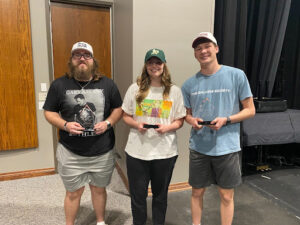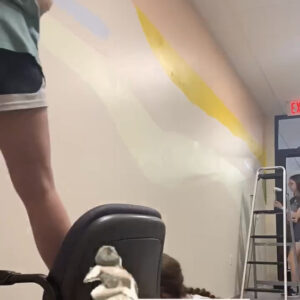Photo by: Will Gentry
“Here today and gone tomorrow” is a phrase that could sum up the way the popularity of viral videos seems to rise and fall.
In the midst of the “Harlem Shake” craze, several different groups of people across the world decided to make their own version of the videos. The men of Kappa Sigma Tau at Oklahoma Christian University participated in this trend and sophomore club member Caleb Henry made an appearance in the video.
“When a video becomes really popular like that, it’s one of those things where you know in three weeks it’s not going to be popular anymore, so you have that window to get one out,” Henry said. “It’s a hilarious video, which is why it’s popular, and so we decided to make our own.”
After the club made the video, they received over 1,000 YouTube views in one night.
“It’s really cool because there’s not that many people in our club, which means a lot of people who aren’t in our club watched the video,” Henry said. “After that, it just kind of died a week later.”
The “Gangnam Style” video is the most watched video in history. Henry said the video became popular because it was fun and so different than any other video.
“A video that has … a good dance that goes along with it for you to imitate outside of just watching the video are usually the ones that people like,” Henry said. “I think they’re awesome. I try to get involved as much as possible. Some of them are too hard to imitate, and that’s why I like the ‘Harlem Shake;’ because it’s easy.”
Some people consider YouTube a waste of time, and although Henry enjoys watching YouTube videos, he agrees.
“I think YouTube is legitimately one of the biggest wastes of time on the Internet,” Henry said. “You can find so much good on there, but I’ve spent hours sifting through compilations of people falling. It’s so much fun, but it’s such a waste of time, and viral videos are the same way.”
Senior marketing major Emily Lundblad said that using viral videos could be marketable.
“I think that with a good viral , everybody will see it,” Lundblad said. “If you want your product to sell, you want people to see it. When things go viral it creates more buzz.”
Although these videos can be used for advertising, Lundblad said that they have their pros and cons.
“Everybody knows what it is, but it can also get a bad reputation,” Lundblad said. “For example, if you use a celebrity to advertise your product to do the ‘Harlem Shake,’ and then the next weekend they go and get drunk, that looks bad for your company.”
While the nation may find the “Harlem Shake” videos amusing, Lundblad isn’t part of that group.
“I like [viral videos],” Lundblad said. “YouTube is taking over. I think they’re entertaining and get attention. But the ‘Harlem Shake,’ for example, is very weird.”
Associate Professor of Communications Joshua Watson said that videos are effective only only when they are done well. If they’re done badly and are embarrassing, then they achieve the opposite effect.
“I have some friends that created one of the top viral videos in the last three or four weeks on YouTube, and it was called ‘Kid President,’” Watson said. “These were a couple of people I went to college with and directed in plays. But they created this video and they just wanted to create a message of hope and doing good.”
Videos aren’t effective when the creators are just trying to sell a product, according to Watson. The Kid President videos are an example of the authenticity that Watson said is necessary for viral video success.
“They were just being themselves,” Watson said. “It was edited well, they had catchy music, but they also had a really good story about a 9-year-old boy who has a bone disease, and who’s had 75 breaks, and he’s telling you to suck it up and don’t make excuses; make a difference in the world. So that just resonated with a lot of people.”
Watson and one of his classes is starting a viral video campaign in which they will try to help raise money for a little girl with liver cancer whom Kid President gives a shout out to on one of his videos.
“At the end of the video he says ‘this is for my friend Gabby who’s fighting cancer like a boss,’ and it was pretty funny to hear him say that,” Watson said. “So, I challenged my class to come up with a plan to help Gabby.”
Not only would the class’ campaign potentially help save a little girl’s life, they would also be helping Gabby’s parents save a lot of money. Her parents were Watson’s college classmates.
“One idea we’re kicking around is the 30 day, 30-K challenge to try and raise some money online to help Gabby’s family pay for her liver transplant, which is around half of a million dollars,” Watson said.
A few tips that Watson suggests are that videos should be short but not offensive, between one and four minutes in length and should have a general appeal.
“It can’t be so niched that only a handful of people would care and everyone else wouldn’t forward it on,” Watson said. “It needs to be simple, memorable, and it helps if it has some sort of greater good. The Old Spice commercials sort of went viral. They didn’t tie into a greater good, but they were so unique compared to common advertising.”
Watson said it would be great if people of faith were known for creating inspiring videos.
“I would like OC students to get more involved with this,” Watson said. “If they’re thinking about things other than themselves and not trying to make a buck, they might be surprised, with a little creativity, how big something could get.”
According to Watson, anybody can have success with a viral video because everyone has a laptop and the capability to record a video.
“I think a lot of people try to make videos viral, and they just didn’t think through it very well,” Watson said. “I think it would be great if more people took the ‘Kid President’ approach of ‘let’s do something good and fun.’”















Be First to Comment